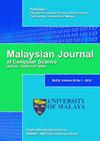MELODY TRAINING WITH SEGMENT-BASED TILT CONTOUR FOR QURANIC TARANNUM
IF 1.1
4区 计算机科学
Q4 COMPUTER SCIENCE, ARTIFICIAL INTELLIGENCE
引用次数: 0
Abstract
Tarannum, or melodic recitation of Quranic verses, employs the softness of the voice in reading the holy verses of the Quran. Melody training technology allows users to practise repetitively while also providing feedback on their performance. This paper describes an application that captures the pattern of tarannum melodies (from Quranic recitations) and provides feedback to the user. Recordings of Quranic verses are collected from an expert reciting Bayati tarannum. The samples are pre-processed into segmented tarannum verse-contours using pitch sequences. Using the k-Nearest Neighbor (kNN) classifier, the melody patterns are trained on 20 samples. Input vectors are formed by computing the melody verse-contour representation using mean, standard deviation, and slope values and combining them with an identified Tilt-based contour label. A tarannum training prototype is built to test similarity between a user’s recitation and the trained patterns. To identify similarity between a pair of verse-contours, the application employs a shape-based contour similarity algorithm. The proposed application also provides feedback in the form of a grade and a percentage of accuracy, as determined by a melody curve similarity algorithm. As results, the current samples have an overall shape-based weighted score of 66%. Some samples are successfully classified with a similarity score as high as 80% individually. The study provides an alternative interactive session for people who want to learn Tarannum, as well as a preliminary step toward understanding the melodic patterns for tarannum. The application provides a repetitive training experience and encourages users to improve their recitations in order to achieve the highest possible score.基于分段倾斜轮廓的曲美塔兰农旋律训练
Tarannum,或古兰经诗句的旋律朗诵,在阅读《古兰经》的神圣诗句时使用了柔和的声音。旋律训练技术允许用户反复练习,同时提供对其表现的反馈。本文描述了一个应用程序,它可以捕捉塔兰农旋律的模式(来自古兰经背诵)并向用户提供反馈。古兰经经文的记录是从一位背诵巴亚提·塔兰努姆的专家那里收集的。使用音高序列将样本预处理为分段的塔兰农诗句轮廓。使用k近邻(kNN)分类器,在20个样本上训练旋律模式。输入向量是通过使用平均值、标准差和斜率值计算旋律诗句轮廓表示,并将它们与已识别的基于倾斜的轮廓标签组合而形成的。建立了一个tarannum训练原型来测试用户的背诵和训练模式之间的相似性。为了识别一对横向轮廓之间的相似性,该应用程序采用了基于形状的轮廓相似性算法。所提出的应用程序还提供由旋律曲线相似性算法确定的等级和准确率百分比形式的反馈。结果,当前样本具有66%的基于形状的总体加权得分。一些样本被成功分类,单个样本的相似性得分高达80%。这项研究为想要学习塔兰农的人提供了一个替代的互动环节,也是理解塔兰农旋律模式的初步步骤。该应用程序提供了重复的训练体验,并鼓励用户改进背诵,以获得尽可能高的分数。
本文章由计算机程序翻译,如有差异,请以英文原文为准。
求助全文
约1分钟内获得全文
求助全文
来源期刊

Malaysian Journal of Computer Science
COMPUTER SCIENCE, ARTIFICIAL INTELLIGENCE-COMPUTER SCIENCE, THEORY & METHODS
CiteScore
2.20
自引率
33.30%
发文量
35
审稿时长
7.5 months
期刊介绍:
The Malaysian Journal of Computer Science (ISSN 0127-9084) is published four times a year in January, April, July and October by the Faculty of Computer Science and Information Technology, University of Malaya, since 1985. Over the years, the journal has gained popularity and the number of paper submissions has increased steadily. The rigorous reviews from the referees have helped in ensuring that the high standard of the journal is maintained. The objectives are to promote exchange of information and knowledge in research work, new inventions/developments of Computer Science and on the use of Information Technology towards the structuring of an information-rich society and to assist the academic staff from local and foreign universities, business and industrial sectors, government departments and academic institutions on publishing research results and studies in Computer Science and Information Technology through a scholarly publication. The journal is being indexed and abstracted by Clarivate Analytics'' Web of Science and Elsevier''s Scopus
 求助内容:
求助内容: 应助结果提醒方式:
应助结果提醒方式:


